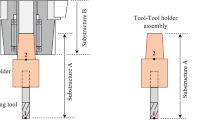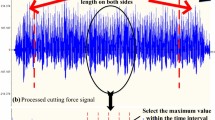Abstract
A new approach for updating model-based stability chart predictions in milling based on experimental data is presented. The approach utilizes Deep Neural Networks (DNNs), which are pre-trained with simulated data that is generated by predicting machine dynamics through receptance coupling and evaluating stability through an analytical stability model. The weights in the DNN are fine-tuned by re-training the networks with a small experimental dataset containing only a few dozen samples. Target is to match network predictions with the experimentally observed stability states acquired under different cutting conditions. The presented approach avoids measurement or model-based estimation of cutting force coefficients as well as the measurement of tooltip dynamics or extensive model parameter identification, making it an attractive approach for industrial applications. In an experimental validation, where stability charts for various engagement conditions and different tool clamping lengths are predicted, a good match between predictions and experimental stability limits is achieved. It is shown that an ensemble learning method, where predictions of multiple networks are combined, can improve prediction accuracy. Furthermore, it is demonstrated that the new approach requires approximately five times fewer experimental samples than previously proposed model-free machine learning approaches to reach the same prediction accuracy on a test set.

















Similar content being viewed by others
References
Budak E, Altintas¸ Y, Armarego EJA (1996) Prediction of milling force coefficients from orthogonal cutting data. J Manuf Sci Eng 118(2):216–224
Altintas Y (2011) Manufacturing automation: metal cutting mechanics, machine tool vibrations, and CNC design, 2nd edn. Cambridge University Press, Cambridge
Grossi N (2017) Accurate and fast measurement of specific cutting force coefficients changing with spindle speed. Int J Precis Eng Manuf 18(8):1173–1180
Rubeo MA, Schmitz TL (2016) Milling force modeling: a comparison of two approaches. Procedia Manufacturing 5:90–105
Campatelli G, Scippa A (2012) Prediction of milling cutting force coefficients for aluminum 6082-T4. Procedia CIRP 1:563–568
Schmitz TL, Donalson RR (2000) Predicting high-speed machining dynamics by substructure analysis. CIRP Ann 49(1):303–308
Schmitz TL, Davies MA, Kennedy MD (2001) Tool point frequency response prediction for high-speed machining by RCSA. J Manuf Sci Eng 123(4):700–707
Park SS, Altintas Y, Movahhedy M (2003) Receptance coupling for end mills. Int J Mach Tools Manuf 43(9):889–896
Namazi M, Altintas Y, Abe T, Rajapakse N (2007) Modeling and identification of tool holder–spindle interface dynamics. Int J Mach Tools Manuf 47(9):1333–1341
Albertelli P, Goletti M, Monno M (2013) A new receptance coupling substructure analysis methodology to improve chatter free cutting conditions prediction. Int J Mach Tools Manuf 72:16–24
Kops L, Vo DT (1990) Determination of the equivalent diameter of an end mill based on its compliance. CIRP Ann 39(1):93–96
Ozsahin O, Altintas Y (2015) Prediction of frequency response function (FRF) of asymmetric tools from the analytical coupling of spindle and beam models of holder and tool. Int J Mach Tools Manuf 92:31–40
Yang Y, Zhang W-H, Ma Y-C, Wan M (2015) Generalized method for the analysis of bending, torsional and axial receptances of tool–holder–spindle assembly. Int J Mach Tools Manuf 99:48–67
Matthias W, Özşahin O, Altintas Y, Denkena B (2016) Receptance coupling based algorithm for the identification of contact parameters at holder–tool interface. CIRP J Manuf Sci Technol 13:37–45
Özsahin O, Ertürk A, Özgüven HN, Budak E (2009) A closed-form approach for identification of dynamical contact parameters in spindle–holder–tool assemblies. Int J Mach Tools Manuf 49(1):25–35
Matsubara A, Asano K, Muraki T (2015) Contactless dynamic tests for analyzing effects of speed and temperature on the natural frequency of a machine tool spindle High Speed Machining, 1
Cao Y, Altintas Y (2005) A general method for the modeling of spindle-bearing systems. J Mech Des 126(6):1089–1104
Jamil N, Yusoff AR (2016) Electromagnetic actuator for determining frequency response functions of dynamic modal testing on milling tool. Measurement 82:355–366
Postel M, Bugdayci NB, Monnin J, Kuster F, Wegener K (2018) Improved stability predictions in milling through more realistic load conditions. Procedia CIRP 77:102–105
Zaghbani I, Songmene V (2009) Estimation of machine-tool dynamic parameters during machining operation through operational modal analysis. Int J Mach Tools Manuf 49(12–13):947–957
Ozsahin O, Budak E, Ozguven HN (2015) In-process tool point FRF identification under operational conditions using inverse stability solution. Int J Mach Tools Manuf 89:64–73
Grossi N, Campatelli G (2016) Identification of machine tool dynamics under operational conditions, in Annual Meeting of the Machine Tool Technologies Research Foundation (MTTRF 2016): San Francisco, CA, USA
Eynian M (2019) In-process identification of modal parameters using dimensionless relationships in milling chatter. Int J Mach Tools Manuf 143:49–62
Friedrich J, Hinze C, Renner A, Verl A, Lechler A (2017) Estimation of stability lobe diagrams in milling with continuous learning algorithms. Robot Comput Integr Manuf 43:124–134
Cherukuri H, Perez B, Selles M, Schmitz T (2019) Machining chatter prediction using a data learning model. J Manuf Mater Process 3:45
Budak E, Ertürk A, Özgüven HN (2006) A modeling approach for analysis and improvement of spindle-holder-tool assembly dynamics. CIRP Ann 55(1):369–372
Park SS, Chae J (2008) Joint identification of modular tools using a novel receptance coupling method. Int J Adv Manuf Technol 35(11):1251–1262
Ertürk A, Özgüven HN, Budak E (2007) Effect analysis of bearing and interface dynamics on tool point FRF for chatter stability in machine tools by using a new analytical model for spindle–tool assemblies. Int J Mach Tools Manuf 47(1):23–32
Budak E, Altintas Y (1998) Analytical prediction of chatter stability in milling—part I: general formulation. J Dyn Syst Meas Control 120(1):22–30
Liao J, Zhang J, Feng P, Yu D, Wu Z (2017) Identification of contact stiffness of shrink-fit tool-holder joint based on fractal theory. Int J Adv Manuf Technol 90(5):2173–2184
Mamedov A, Layegh KSE, Lazoglu I (2013) Machining forces and tool deflections in micro milling. Procedia CIRP 8:147–151
Murphy KP (2012) Machine learning: a probabilistic perspective. MIT Press
Friedrich J, Hinze C, Lechler A, Verl A (2016) On-line learning artificial neural networks for stability classification of milling processes. In 2016 IEEE International Conference on Advanced Intelligent Mechatronics (AIM).P. 357-364
Acknowledgments
The contribution of Georg Fischer Machining Solutions (GFMS) to this work is greatly appreciated.
Funding
This study received financial support from the Commission for Technology and Innovation (CTI) of the Federal Department of Economic Affairs of Switzerland.
Author information
Authors and Affiliations
Corresponding author
Ethics declarations
Conflict of interest
The authors declare that they have no conflict of interest.
Additional information
Publisher’s note
Springer Nature remains neutral with regard to jurisdictional claims in published maps and institutional affiliations.
Rights and permissions
About this article
Cite this article
Postel, M., Bugdayci, B. & Wegener, K. Ensemble transfer learning for refining stability predictions in milling using experimental stability states. Int J Adv Manuf Technol 107, 4123–4139 (2020). https://doi.org/10.1007/s00170-020-05322-w
Received:
Accepted:
Published:
Issue Date:
DOI: https://doi.org/10.1007/s00170-020-05322-w




